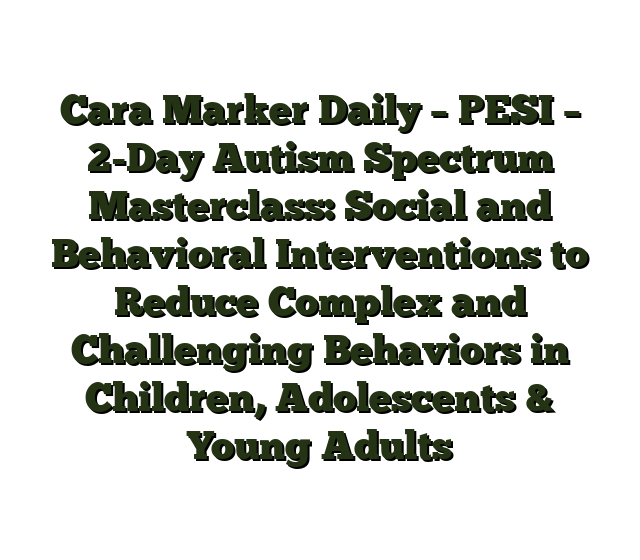Cara Marker Daily – PESI – 2-Day Autism Spectrum Masterclass: Social and Behavioral Interventions to Reduce Complex and Challenging Behaviors in Children, Adolescents & Young Adults
Cara Marker Daily – PESI – 2-Day Autism Spectrum Masterclass: Social and Behavioral Interventions to Reduce Complex and Challenging Behaviors in Children, Adolescents & Young Adults course is now available at an affordable price. You can check out directly using multiple payment gateway options. If you have any questions or need an alternative payment method, feel free to contact us.
Cara Marker Daily – PESI – 2-Day Autism Spectrum Masterclass: Social and Behavioral Interventions to Reduce Complex and Challenging Behaviors in Children, Adolescents & Young Adults
Begin by joining autism expert and author, Cara Daily, PhD, BCBA, and learn the most effective evidence-based social and behavioral interventions for working with the pervasive comorbid disorders and symptoms associated with ASD.
Dr. Daily makes this complex disorder easy to understand—you will leave with the interventions and skills required to confidently teach children, adolescents and young adults with autism how to live more independent and fuller lives!
Learn how to integrate the latest research on brain development, visual and environmental modifications, cognitive-behavioral interventions and successful psychosocial techniques to help clients manage challenging behaviors related to ASD.
Through engaging case studies, demonstrations, and hands-on activities you will learn the skills necessary to:
Manage emotional and physical reactions to anxiety and OCD
Turn maladaptive behaviors around and reduce meltdowns
Improve attention, motivation and organizational skills
Decode ADHD and Executive Functioning in ASD
Decipher symptoms of OCD vs. ASD
Reduce depressive symptoms and suicidal ideation
Strengthen the skills needed to make/keep friends
Address body and sexual awareness, exploration of self, sexual arousal
Recognize what trauma looks like with ASD
Expose clients to more appropriate self-stimulatory behaviors
Accurately interpret assessment reports to guide effective interventions
Use classroom modifications for preferential seating, successful transitions and alternate task-taking
Learn the essential autism treatment tools that are easy to implement in the clinic, at school and home!
Objectives
Assess, screen and diagnose Autism Spectrum Disorder (ASD) using DSM-5® and future ICD-11 diagnostic criteria.
Differentiate between neurological abilities and impairments in clients diagnosed with ASD.
Create a comprehensive treatment plan that targets symptoms of ASD based on results of comprehensive evaluations.
Evaluate and develop your communication style to facilitate effective, reciprocal conversations with clients diagnosed with ASD.
Utilize developmentally-appropriate interventions to teach your clients with ASD how to engage in appropriate sexual behaviors.
Employ sensory-based relaxation techniques to reduce symptoms of anxiety in your clients with ASD.
Employ visual strategies to assist clients with executive functioning deficits.
Evaluate the ethical dilemmas associated with utilizing specific punishment techniques, including timeout and seclusion.
Utilize techniques of mindfulness, CBT, and family therapy to treat depression in clients with ASD.
Develop a plan for effective coping with clients experiencing anxious situations.
Integrate techniques of exposure and response prevention in treating OCD with clients who have been diagnosed with ASD.
Demonstrate the potential side effects of psychotropic medication that can mimic or cause behavioral issues related to ASD.
Outline
Neuropsychology: How the Brain with Autism Works
Latest research in ASD brain development
Comorbid disorders and symptoms
Enhanced vs. impaired abilities
Information processing: Typical brain vs. brain with autism
How an individual with ASD processes tasks
Assessments: From Observational to Standardized Tools
Comprehensive diagnostic tools and evaluations
Screeners for anxiety, depression, OCD
Career planning assessments
Modified checklists for infants and toddlers
Accurately interpret reports to guide interventions
Ethical challenges in assessment and communication of diagnosis
TAKE YOUR AUTISM INTERVENTION TO THE NEXT LEVEL!
Effectively Intervene Early
Applied Behavioral Analysis to break down targeted skills
Developmental interventions to express feelings and form relationships
Educational interventions for parents
Ethical principles to educate and support families in treatment choices
Case study: 2-year-old boy, working on verbal requests
Strengthen Communication and Social Interaction Skills
Visual systems to improve communication and reduce meltdowns
Teach turn-taking and pragmatic language
Programs to assist in generalizing social skills
Video modeling and role play to teach social rules
Social stories and social autopsies
Special interests to change unwanted or inappropriate behavior
Case study: 8-year-old male, competitive, difficulty losing at games, aggressive with peers
Manage Sensory Overload and Self-Stimulatory Behaviors
Exposure to more appropriate self-stimulatory behaviors
Fading out severe self-stimulatory behaviors
Environmental strategies including classroom modifications
Case study: 6-year-old female, hand flapping, rocking, and high-pitch squealing sounds
Decode ADHD and Executive Functioning in ASD
Improve attention, on-task and organizational skills
Schedules, timelines, web diagramming
How to provide more preferred tasks vs. less preferred tasks
“Home base” to help organize in classroom
Case study: 11-year-old male, difficulty planning/ organizing, needs help with social pragmatic language skills
Decrease Undesirable Physical, Verbal and Other Inappropriate Behaviors
Turn noncompliance and oppositional behavior around
Applied behavioral analysis techniques
Token economy systems
Functional behavioral assessment made easy
Case study: 10-year old male, impulsive, engages in stealing behaviors
Manage Anxiety and Specific Phobias
Cognitive Behavioral and Coping Cat Training
Recognize emotional and physical reactions to anxiety
Clarifying thoughts and feelings in anxious situations
Develop plans for effective coping
Evaluate performance and giving self-reinforcement
Case study: 9-year old male, generalized anxiety disorder, and school phobia
Decrease Obsessive-Compulsive Behaviors
Decipher symptoms of OCD vs ASD
CBT and Exposure and Response Prevention
Mapping OCD
Creating the exposure hierarchy
Relapse prevention and family sessions
Case study: 22-year old female, excessive hand washing with fear of illness
Reduce Depressive Symptoms and Suicidal Ideation
Psychosocial interventions: Experiential activities with practice time
Cognitive-behavioral therapies
Mindfulness-based therapies
Family therapies
Social and vocational programs
Case study: 15-year-old male, hates school and has a plan, intent, and timeline for suicide
Sexuality and Sexual Behavior Challenges
Body awareness and exploration of self
Sexual arousal, puberty and sex education
Address dating and sexual relationships
Education on masturbation and pornography
Gender Identity and LGBTQ
Case study: 14-year-old male, frequent masturbation and stalking behaviors
Psychopharmacological Interventions
Commonly prescribed medications
Medication efficacy
Risks vs. benefits
Case study: 17-year-old male, flat affect, on medication for ADHD and anxiety
Special Considerations
Trauma: Similarities and differences with ASD
Independent living and career planning
Guardianship and legal Issues
Multicultural and gender differences
Limitations of research and potential risks
Case study: 5-year-old male, adopted overseas with no birth or developmental history
Case Study: 19-year-old female, living at home with mom, no job, and never diagnosed with ASD
Ethical Challenges in Autism
Guidelines for assessment, treatment, and consultation
Welfare of the individual Informed consent
Use of restraints
Time-out vs. seclusion
Case study: 8-year-old-male, screaming, standing on top of table with scissors in his hand
Target Audience
Psychologists
Counselors
Social Workers
Marriage and Family Therapists
School Psychologists
School Counselors
School Social Workers
Speech-Language Pathologists
Occupational Therapists
Occupational Therapy Assistants
School Administrators
Special Education Teachers
General Education Teachers
School-based Personnel
Behavioral Intervention Specialists
Psychiatrists Educational
Paraprofessionals
Nurses
Youth Leaders
Probation Officers
Clergy
Other helping professionals who work with children/adolescents/young adults
Delivery Policy
When will I receive my course?
You will receive a link to download/view your course immediately or within 1 to 24 hrs. It may takes few minutes, also few hours but never more than 24 hrs. Due to different time zone reasons.
How is my course delivered?
We deliver courses through Google Drive or Telegram. Once your order is complete, you?ll receive an email with a Google Drive or Telegram channel access link to view/download the course.
In case you submit a wrong email address, please contact us to resend the course to the correct email.
Where can I find my course?
Upon completing your order, a link to download or access the course will be sent to your email. Alternatively, you can find it in the ‘My Account’ download section.
If you do not see it there, please share a screenshot of your order and payment with me on Telegram at @ bossallcourses_bot to ensure prompt assistance. I am highly responsive on Telegram.








Reviews
There are no reviews yet.